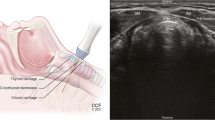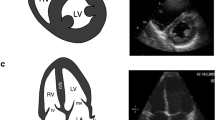Abstract
Introduction
Lasers 2-µm in wavelength offer efficient tissue cutting with limited thermal damage in biological tissue.
Objective
To evaluate the dissection capabilities of a 2-μm continuous-wave laser for NOTES procedures.
Methods and Procedures
We conducted 18 acute animal experiments. Group 1 (three animals): transcolonic access to the peritoneal cavity (15-W transcolonic laser puncture, balloon dilation over the laser probe). Group 2 (six animals): transcolonic access with needle-knife puncture and balloon dilation. Group 3 (three animals): transgastric access to the peritoneal cavity (similar technique as group 1) followed by laser-assisted dissection of the kidney. In one animal of group 3, a therapeutic target (hematoma) was created by percutaneous puncture of the kidney. Group 4 (six animals): transgastric access (similar to the technique of group 2).
Results
Translumenal access to the peritoneal cavity was achieved in 2–3 min in group 1 (significantly shorter than with the needle-knife-assisted technique, 4–5 min, p = 0.02) and in 7–10 min in group 3 (compared to 6–17 min in group 4, p = 0.88). In group 3, laser dissection of the parietal peritoneum and of perinephric connective tissue allowed access to the retroperitoneum with complete removal of a blood collection in the animal with puncture trauma. Laser dissection demonstrated good maneuverability, clean and rapid cutting, and excellent hemostasis. Peritoneoscopy and necropsy showed no damage of targeted tissue and surrounding organs.
Conclusions
The 2-μm continuous-wave laser system showed promising capabilities for highly precise and safe dissection during NOTES procedures.




Similar content being viewed by others
References
Giday SA, Kantsevoy SV, Kalloo AN. Current status of natural orifice translumenal surgery. Gastrointest Endosc Clin N Am. 2007;17:595–604.
Rattner D, Kalloo A. ASGE/SAGES Working Group on Natural Orifice Translumenal Endoscopic Surgery. October 2005. Surg Endosc. 2006;20:329–333.
Fujishiro M. Endoscopic submucosal dissection for stomach neoplasms. World J Gastroenterol. 2006;12:5108–5112.
Fried NM. High-power laser vaporization of the canine prostate using a 110 W Thulium fiber laser at 1.91 µm. Lasers Surg Med. 2005;36:52–56.
Fried NM, Murray KE. High-power thulium fiber laser ablation of urinary tissues at 1.94 µm. J Endourol. 2005;19:25–31.
Zeitels SM, Burns JA, Akst LM, Hillman RE, Broadhurst MS, Anderson RR. Office-based and microlaryngeal applications of a fiber-based thulium laser. Ann Otol Rhinol Laryngol. 2006;115:891–896.
Bach T, Herrmann TR, Cellarius C, Gross AJ. Bladder neck incision using a 70 W 2 micron continuous wave laser (RevoLix). World J Urol. 2007;25:263–267.
Bui MH, Breda A, Gui D, Said J, Schulam P. Less smoke and minimal tissue carbonization using a thulium laser for laparoscopic partial nephrectomy without hilar clamping in a porcine model. J Endourol. 2007;21:1107–1111.
Burns JA, Kobler JB, Heaton JT, Lopez-Guerra G, Anderson RR, Zeitels SM. Thermal damage during thulium laser dissection of laryngeal soft tissue is reduced with air cooling: ex vivo calf model study. Ann Otol Rhinol Laryngol. 2007;116:853–857.
Koufman JA, Rees CJ, Frazier WD, et al. Office-based laryngeal laser surgery: a review of 443 cases using three wavelengths. Otolaryngol Head Neck Surg. 2007;137:146–151.
Seitz M. Editorial comment on: thulium laser versus standard transurethral resection of the prostate: a randomized prospective trial. Eur Urol. 2008;53:390.
Xia SJ, Zhuo J, Sun XW, Han BM, Shao Y, Zhang YN. Thulium laser versus standard transurethral resection of the prostate: a randomized prospective trial. Eur Urol. 2008;53:382–389.
Gao X, Ren S, Xu C, Sun Y. Thulium laser resection via a flexible cystoscope for recurrent non-muscle-invasive bladder cancer: initial clinical experience. BJU Int. 2008;102(9):1115–1118.
Quaden R, Attmann T, Schunke M, Theisen-Kunde D, Cremer J, Lutter G. Percutaneous aortic valve replacement: endovascular resection of human aortic valves in situ. J Thorac Cardiovasc Surg. 2008;135:1081–1086.
Ayari-Khalfallah S, Fuchsmann C, Froehlich P. Thulium laser in airway diseases in children. Curr Opin Otolaryngol Head Neck Surg. 2008;16:55–59.
Treat MR, Trokel SL, Reynolds RD, et al. Preliminary evaluation of a pulsed 2.15-micron laser system for fiberoptic endoscopic surgery. Lasers Surg Med. 1988;8:322–326.
Wendt-Nordahl G, Huckele S, Honeck P, et al. Systematic evaluation of a recently introduced 2-micron continuous-wave thulium laser for vaporesection of the prostate. J Endourol. 2008;22:1041–1045.
Sumiyama K, Gostout CJ. Techniques for transgastric access to the peritoneal cavity. Gastrointest Endosc Clin N Am. 2008;18:235–244.
Ryou M, Thompson C. Techniques for transanal access to the peritoneal cavity. Gastrointest Endosc Clin N Am. 2008;18:245–260.
Sohn DK, Turner BG, Gee DW, Willingham FF, Sylla P, Cizginer S, Konuk Y, Brugge WR, Rattner DW. Reducing the unexpectedly high rate of injuries caused by NOTES gastrotomy creation. Surg Endosc. 2010;24(2):277–282.
Liang JH, Xu CL, Wang LH, Hou JG, Gao XF, Sun YH. Irrigation eliminates smoke formation in laser laparoscopic surgery: ex vivo results. Surg Laparosc Endosc Percutan Tech. 2008;18:391–394.
Jagannath SB, Kantsevoy SV, Vaughn CA, et al. Peroral transgastric endoscopic ligation of fallopian tubes with long-term survival in a porcine model. Gastrointest Endosc. 2005;61:449–453.
Kantsevoy SV, Jagannath SB, Niiyama H, et al. Endoscopic gastrojejunostomy with survival in a porcine model. Gastrointest Endosc. 2005;62:287–292.
Kantsevoy SV, Hu B, Jagannath SB, et al. Transgastric endoscopic splenectomy: is it possible? Surg Endosc. 2006;20:522–525.
Kantsevoy SV, Jagannath SB, Niiyama H, et al. A novel safe approach to the peritoneal cavity for per-oral transgastric endoscopic procedures. Gastrointest Endosc. 2007;65:497–500.
Author information
Authors and Affiliations
Corresponding author
Rights and permissions
About this article
Cite this article
Dray, X., Donatelli, G., Krishnamurty, D.M. et al. A 2-µm Continuous-Wave Laser System for Safe and High-Precision Dissection During NOTES Procedures. Dig Dis Sci 55, 2463–2470 (2010). https://doi.org/10.1007/s10620-010-1214-5
Received:
Accepted:
Published:
Issue Date:
DOI: https://doi.org/10.1007/s10620-010-1214-5




